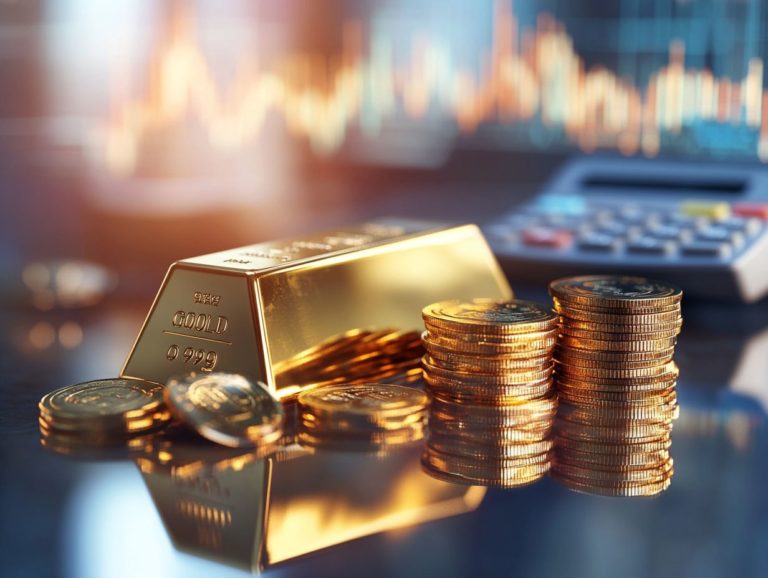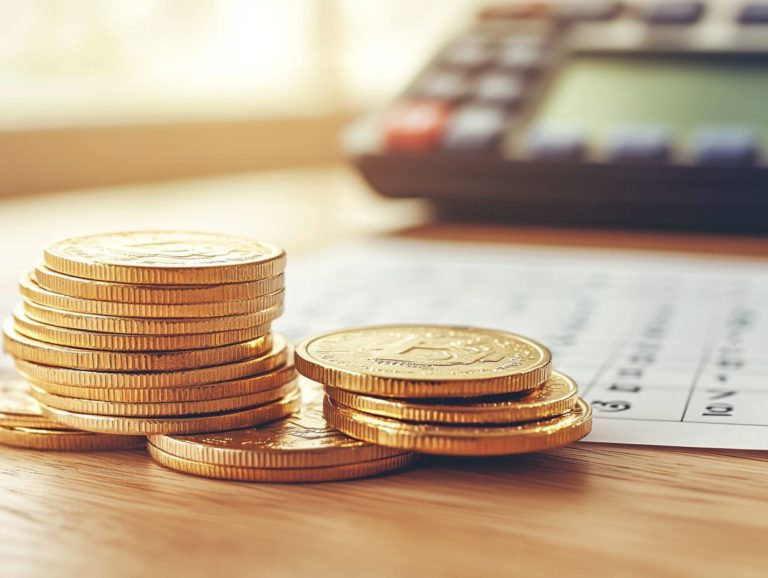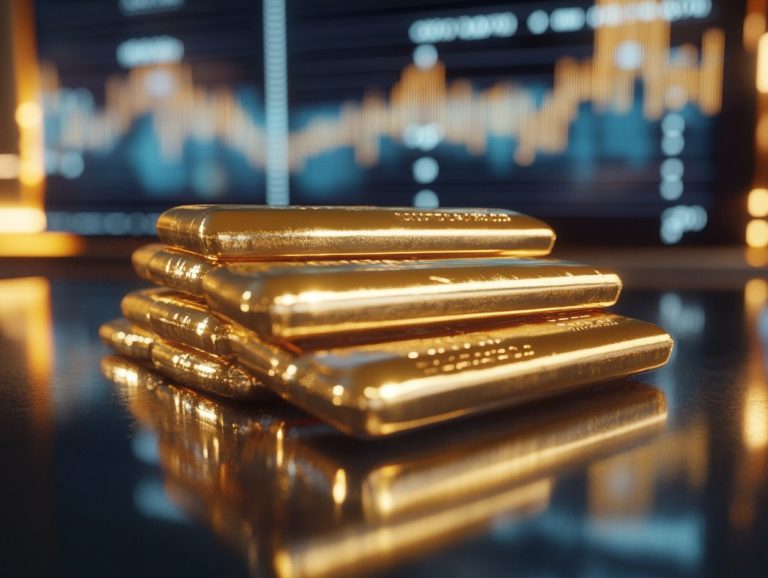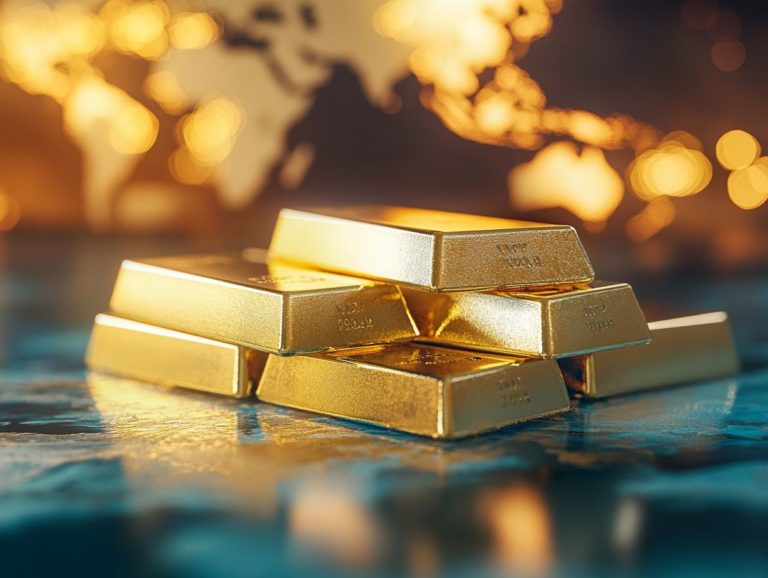5 Must-Know Facts About Gold Futures
Gold futures can serve as a compelling entry point for investors looking to diversify their portfolios. These financial instruments allow you to speculate on the future price of gold, presenting unique opportunities and challenges. This article delves into what gold futures are, how they function, and the benefits and risks that come with investing in them.
It also outlines practical steps to help you get started, addresses common misconceptions, and highlights critical factors that influence gold prices. Whether you re a seasoned investor or simply curious about the gold market, this guide equips you with essential knowledge to make informed decisions.
Contents
- Key Takeaways:
- 1. What Are Gold Futures?
- 2. How Do Gold Futures Work?
- 3. What Are the Benefits of Investing in Gold Futures?
- 4. What Are the Risks of Investing in Gold Futures?
- 5. How Can One Start Investing in Gold Futures?
- What Are the Different Factors That Affect Gold Futures Prices?
- Frequently Asked Questions
Key Takeaways:
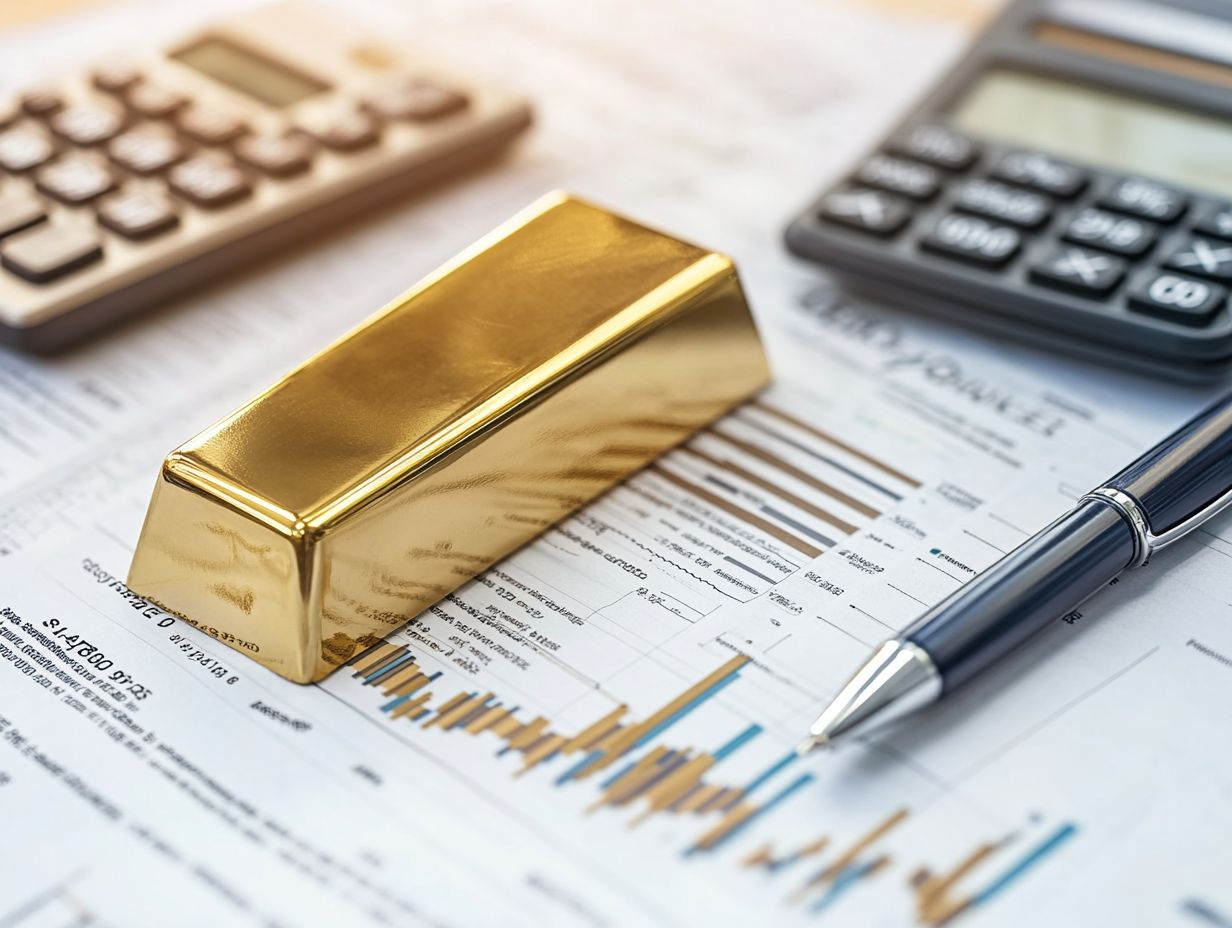
Gold futures are contracts that let you buy or sell gold at a set price later. Investors can benefit from the potential for high returns and diversification through gold futures. However, there are risks involved, such as price volatility and the need for knowledge about market factors.
1. What Are Gold Futures?
Gold futures are financial contracts that obligate you to purchase, and the seller to sell, a specific amount of gold at a predetermined price on a future settlement date. This system helps you trade more easily and opens up investment opportunities for various participants, including speculators and hedgers who aim to manage price risk and market volatility.
These contracts are pivotal in the broader commodities market, as they allow you to lock in prices and mitigate the risks associated with fluctuations in gold prices. As an investor, you can use these futures to hedge against potential declines in the value of your physical gold holdings or to speculate on price movements, aiming to generate profit.
Contract specifications such as size, maturity date, and delivery options are essential, as they dictate the terms of trade and influence liquidity. Unlike other financial instruments like stocks or bonds, gold futures provide leveraged exposure, enabling you to control a larger position with a smaller initial investment. Just keep in mind that this advantage comes with increased risk. For those considering diversifying their portfolio, exploring the risks and rewards of silver investing could be beneficial.
2. How Do Gold Futures Work?
Gold futures operate through a sophisticated system of margin trading, which allows you to leverage financial resources and control larger positions in the gold market. This enables you to speculate on price movements without needing physical delivery of gold bullion.
By investing just a fraction of the total contract value as an initial margin, you can significantly amplify your potential returns. However, it s essential to recognize that this comes with increased risk. The role of futures brokers is crucial in this landscape; they facilitate your trades and ensure compliance with regulatory standards, creating a pathway for both novice and experienced investors to engage in the market.
Be mindful that fluctuations in gold prices can lead to margin calls, requiring you to deposit additional funds to maintain your positions. This adds a layer of complexity to your trading strategy. Familiarizing yourself with these mechanics not only helps you navigate market liquidity but also opens up avenues for profit as you capitalize on price shifts, fostering a dynamic trading environment.
3. What Are the Benefits of Investing in Gold Futures?
Investing in gold futures presents a myriad of benefits. You have the potential for substantial capital gains through speculation, the opportunity to leverage financial instruments for greater investment exposure, and the ability to implement hedging strategies that help mitigate risks tied to market volatility and price fluctuations in the physical commodities sector.
This financial instrument also offers a remarkable level of liquidity, allowing you to enter and exit positions with relative ease, even amidst turbulent markets. For instance, during times of economic uncertainty, gold often sees price surges, creating avenues for profit while traditional equities may struggle.
Gold futures are a smart way to guard against inflation, as gold’s value typically appreciates when the purchasing power of currency diminishes. Many seasoned investors turn to these futures as a dependable strategy for navigating downturns, reinforcing their portfolios through thoughtful allocation that protects their assets during challenging times.
Ready to explore the world of gold futures? Let s dive in and unlock these investment opportunities together!
4. What Are the Risks of Investing in Gold Futures?
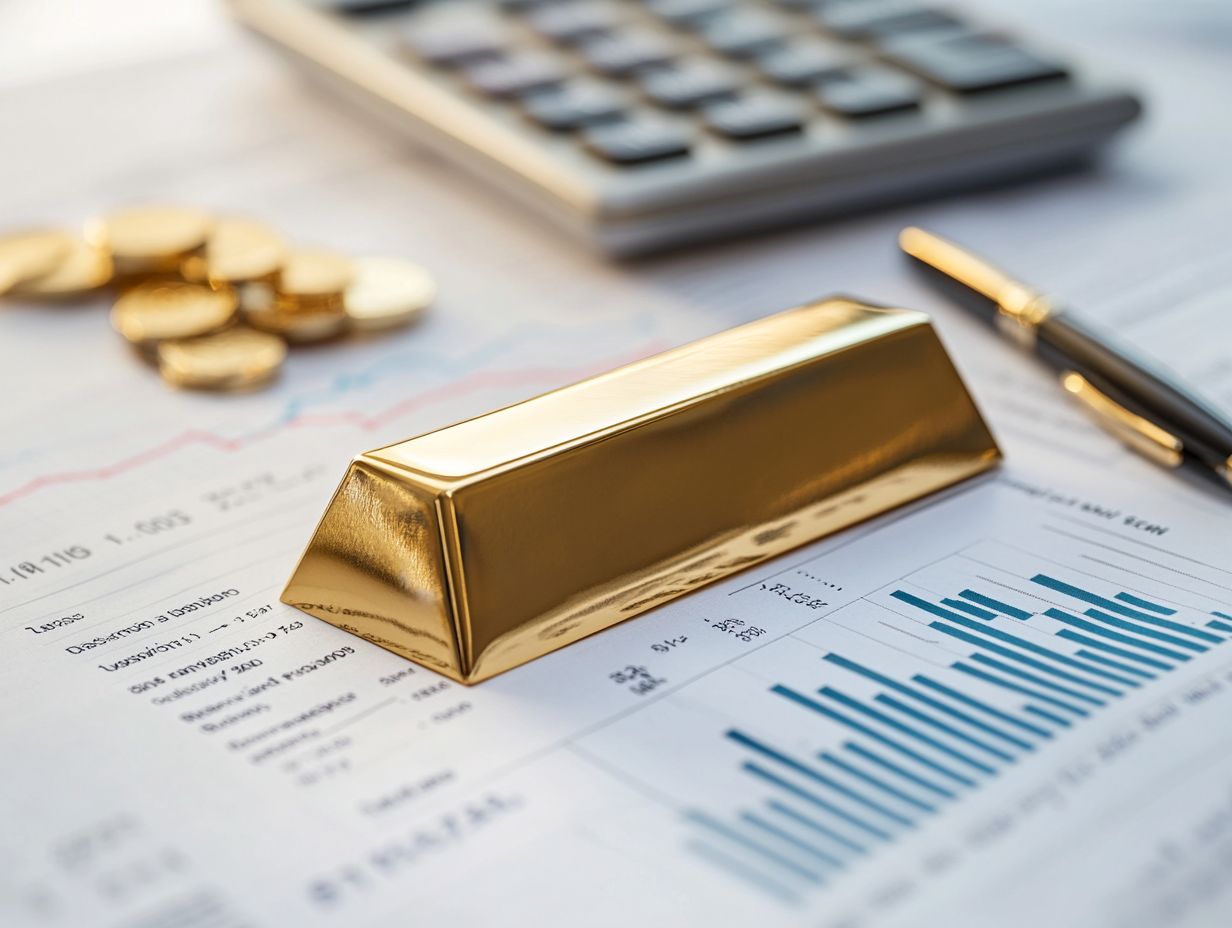
Investing in gold futures can be an exciting opportunity, but beware the risks that come with it. Market volatility, price fluctuations in the spot price of gold, and credit risk (the risk that a financial institution might not fulfill its obligations) tied to the financial integrity of futures exchanges and brokerage firms create an unpredictable landscape, even for the most experienced traders.
The allure of leveraging your investments in gold futures can amplify both potential gains and losses. Keep a sharp eye on your positions. Be aware that margin calls may require more funds if your account balance drops too low, posing a considerable risk, especially during sudden market shifts.
To navigate the uncertainties of this commodity market effectively, implement robust risk management techniques. Setting stop-loss orders (a tool to limit losses by automatically selling an asset when it reaches a certain price) and diversifying your investments are vital strategies to help you weather the inevitable ups and downs of gold futures trading.
5. How Can One Start Investing in Gold Futures?
To embark on your journey into gold futures, start by familiarizing yourself with futures brokers. Selecting a reputable brokerage firm is crucial, as is understanding the contract specifications and engaging in margin trading to effectively participate in the futures market.
Once you ve chosen a suitable broker, also establish a clear investment profile that aligns with your financial goals, risk tolerance, and understanding of the market. Contract specifications cover everything from contract size to expiration dates.
Adopting risk management strategies will enhance your investment experience. Setting stop-loss orders and regularly reviewing market trends will serve you well. By taking these steps, you can navigate the complexities of gold futures with greater confidence and clarity.
What Are the Different Factors That Affect Gold Futures Prices?
Gold futures prices are shaped by a myriad of factors, including the current spot prices of gold, market expectations about future price movements, geopolitical events, and general market fluctuations that influence both supply and demand for gold and other precious metals.
Beyond these influences, economic indicators such as inflation rates, employment figures, and GDP growth can significantly alter the path of your gold investments. Central bank policies are crucial too; their choices regarding interest rates and monetary easing can either enhance or diminish gold s allure as a safe haven asset.
Your sentiment as an investor, often influenced by news cycles and market trends, can also create ripples in gold futures trading. Collectively, these internal and external dynamics create a landscape brimming with opportunities for both seasoned investors and newcomers alike, showcasing the intricate interplay between economic theory and practical investing.
What Are the Differences Between Gold Futures and Physical Gold?
Gold futures stand apart from physical gold as they’re financial instruments designed for speculation and trading, allowing you to engage without the hassle of physical delivery. In contrast, investing in physical gold means actually purchasing gold bullion, which comes with its own set of costs and considerations.
When you invest in gold futures, you typically enjoy greater liquidity since these contracts can be easily traded on various exchanges. On the other hand, selling physical gold often requires more effort, especially if you’re dealing with larger quantities or specialty items. If you’re considering diversifying your investments, investing in silver can also be a valuable option.
The cost implications can vary significantly; while trading futures may require less upfront capital, it can also lead to higher fees and margin requirements. Conversely, owning physical gold involves ongoing storage and insurance costs, but it offers the tangible reassurance of actual ownership.
Each investment approach has its own strategies. Futures might appeal to you if you re focused on short-term market movements, while physical gold often attracts those who prioritize long-term security and wealth preservation.
How Can One Use Gold Futures for Hedging?

Gold futures can serve as a powerful tool for your hedging strategies. They enable you to offset potential losses in your physical gold holdings or other investments amid market volatility and price fluctuations. This approach allows you to manage investment risks with greater finesse.
For instance, if you anticipate a decline in gold prices, you could take a short position in gold futures contracts. This strategy allows you to lock in current prices and potentially profit from the drop, effectively reducing the negative impact on your overall portfolio.
On the flip side, if you hold substantial gold investments but are concerned about a price decline while still wanting to maintain your exposure, you might consider a long position in gold futures. Additionally, to enhance your investment strategy, learning how to educate yourself about silver investing can help diversify your portfolio and cushion potential losses during uncertain times.
What Are the Tax Implications of Investing in Gold Futures?
When investing in gold futures, it’s essential to grasp the tax implications tied to your trades, especially regarding tax on profits from selling investments. This can have a substantial impact on your overall investment returns, depending on the duration and type of futures contracts you hold.
Understanding the calculation of capital gains is vital. The Internal Revenue Service (IRS) classifies profits from the sale of gold futures as either short-term or long-term capital gains, based on how long you ve held the contracts. Short-term gains, applicable to investments held for less than a year, are typically taxed at your ordinary income tax rate, which can be quite steep. Conversely, long-term gains, realized after holding for a year, might qualify for lower tax rates.
You must also navigate specific regulations, such as the ‘25% collectibles tax rate’ on gold. This highlights why careful financial planning is essential!
What Are the Common Myths About Gold Futures?
Gold futures may be gaining traction, but they re often shrouded in myths, such as the notion that they re only for seasoned investors. In truth, anyone can dive into margin trading and speculative strategies with the right education and sound risk management.
This accessibility opens the door for both newcomers and experienced traders eager to diversify their portfolios. You might think that stepping into this market requires a hefty upfront investment or some insider scoop, but that’s simply not true.
There s a wealth of educational resources out there, with numerous platforms offering tutorials, webinars, and paper trading options to help you build confidence. By unraveling the complexities of futures trading, you can craft a solid strategy grounded in well-considered choices.
Grasping the mechanics of using borrowed money to increase potential returns and recognizing the significance of market trends gives you the power to invest responsibly. This allows you to position gold futures as a valuable asset within your broader financial landscape, and understanding the top reasons to invest in silver now can further enhance your investment strategy.
What Are the Key Considerations When Investing in Gold Futures?
When investing in gold futures, you should consider several key factors. This includes understanding the role of futures brokers, setting realistic market expectations, and developing a comprehensive investment profile that reflects your individual risk tolerance and strategies.
Conducting thorough market analysis is essential to spot trends and anticipate potential price movements in gold, as these can significantly influence your decision-making. Selecting the right broker is pivotal; not only does this choice affect your transaction costs, but it also determines your access to quality research and trading tools.
Familiarizing yourself with specific contract specifications, such as expiration dates and margin requirements, can help you reduce risks and maximize your returns. By crafting an effective investment management strategy tailored to the ever-evolving market conditions, you will be well-prepared to navigate any fluctuations in the gold futures landscape, especially if you consider the 8 must-know facts about silver investing.
Frequently Asked Questions
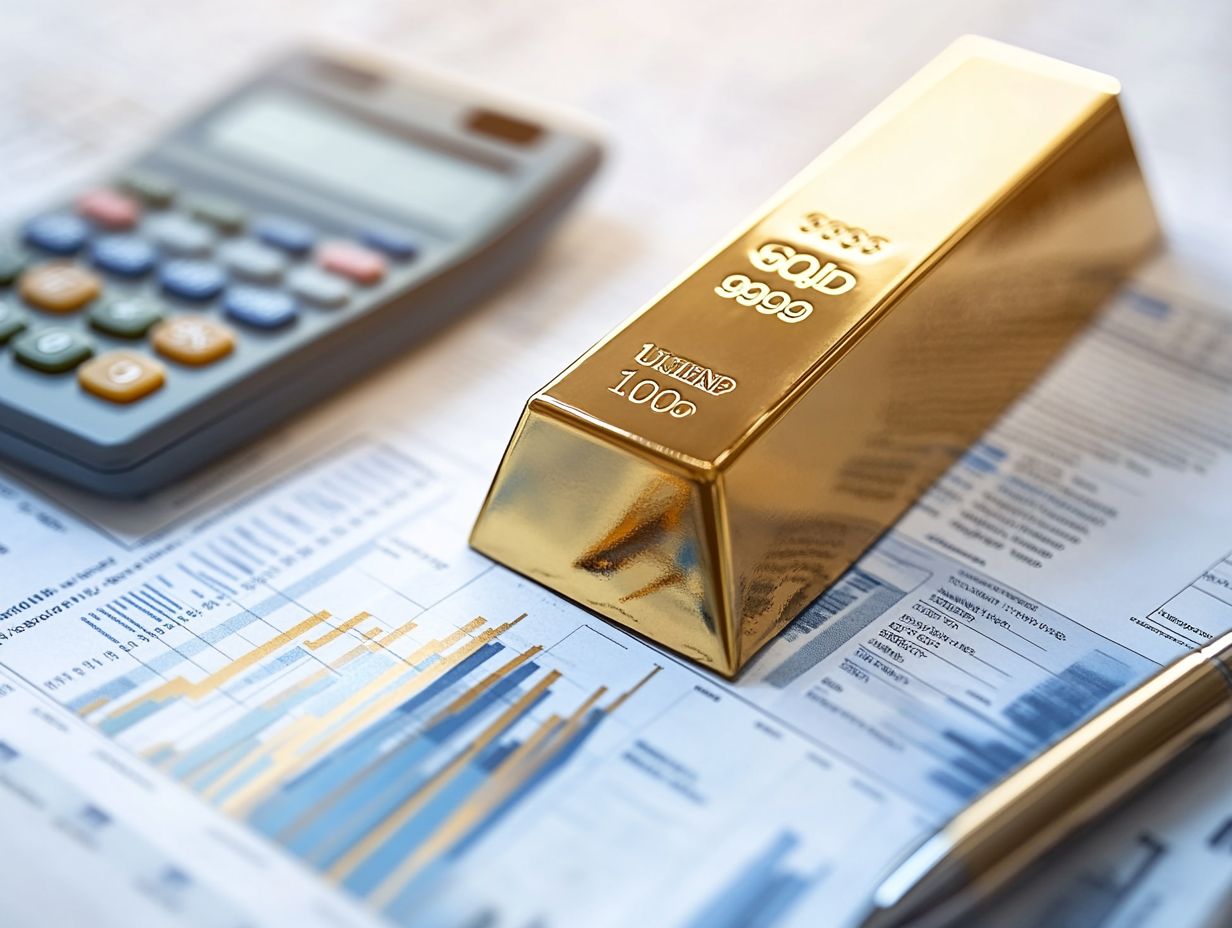
Ready to explore the world of gold futures? Dive deeper into our resources and empower your investment journey today!
What are gold futures?
Gold futures are contracts that allow investors to buy or sell a certain amount of gold at a predetermined price and date in the future. They are traded on commodity exchanges and are a popular way for investors to speculate on gold prices.
How do gold futures work?
Gold futures set a future price for gold based on market conditions. Investors can buy or sell these contracts to profit from price changes.
When the contract expires, the buyer must either take delivery of the gold or settle in cash.
Why are gold futures considered a high-risk investment?
Gold futures are high-risk because they involve speculation on gold prices, which can be very volatile. Prices can fluctuate significantly, leading to potential large gains or losses.
What are the benefits of investing in gold futures?
Investing in gold futures can protect against rising prices and currency fluctuations. It also helps diversify your portfolio, as gold often moves independently of other assets.
Gold futures allow you to control a larger amount of gold with a smaller investment, increasing your potential returns.
What are the risks of investing in gold futures?
While the potential returns are high, gold futures come with inherent risks. These include market volatility and the chance of losing money if gold prices move against your position.
How can I get started investing in gold futures?
Don t wait to explore this lucrative opportunity! Open your account with a commodity broker today. To start investing, you will need to open an account with a broker who gives you access to the futures market.
Research thoroughly and consider working with a financial advisor or an experienced investor before making investment decisions.










